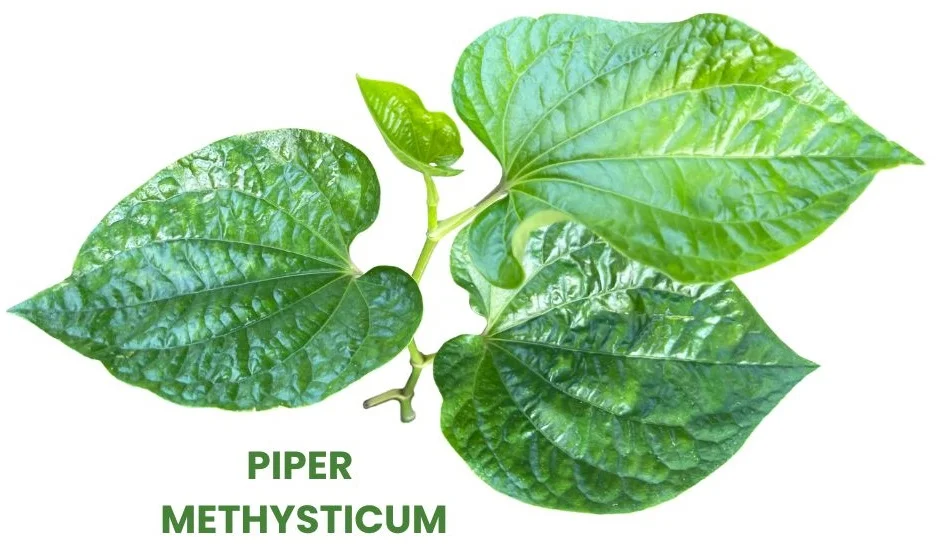Piper methysticum, commonly known as Kava-kava, is a plant native to the South Pacific Islands, particularly Vanuatu, Fiji, and Tonga.
Traditionally, its roots are used to produce a ceremonial drink known for its sedative and anesthetic properties, promoting relaxation and socialization without impairing mental clarity.
The use of Kava has a rich history, intertwined with the cultural practices of Pacific Islanders, where it serves as a symbol of hospitality and friendship.

Table of Contents
ToggleSOURCE INFORMATION
Scientific Classification
- Kingdom: Plantae
- Clade: Angiosperms
- Clade: Eudicots
- Order: Piperales
- Family: Piperaceae
- Genus: Pipe
- Species: Piper methysticum
Origin
- Kava is primarily cultivated in the tropical regions of the South Pacific, thriving in well-drained, moist soil with partial shade.
Historical Facts
- Kava has been used for centuries in traditional Pacific Islander rituals, as well as for its calming effects.
- The name “Kava” is derived from the Polynesian word “awa,” meaning bitter.
- The drink made from Kava roots has been consumed in various ceremonies, including welcome rituals, negotiations, and as a remedy for anxiety and stress.
- Its introduction to Western medicine began in the late 19th and early 20th centuries, where it was recognized for its psychoactive properties.
DRUG PATHOGENESIS
- Kava’s effects are primarily attributed to a group of compounds known as kavalactones.
- These substances act on the central nervous system, promoting relaxation and reducing anxiety without significantly impairing cognitive function.
- Kava has been shown to interact with GABA receptors, enhancing the effects of this neurotransmitter, which is known for its calming effects.
PHYSICAL CONSTITUTION
- Individuals who may benefit from Kava often exhibit a nervous temperament, characterized by restlessness, anxiety, and heightened sensitivity.
WHAT ARE MODALITIES IN HOMOEOPATHY?
KEY CHARACTERISTICS
- Sedative: Promotes relaxation and reduces anxiety.
- Muscle Relaxant: Helps relieve muscle tension.
- Analgesic: May alleviate pain and discomfort.
DETAILED ORGAN SYMPTOMS
MIND
- Very Sensitive: Individuals may feel overwhelmed by stimuli, leading to heightened emotional responses.
- Exaltation of Mind: A state of heightened feelings of happiness or euphoria.
- Amelioration of Pains: Distraction from pain through a change of focus; the mind’s engagement can temporarily relieve discomfort.
- Restless Desire to Change Position: An inability to remain still, often requiring physical movement for comfort.
URINARY SYSTEM
- Increased Urination: A diuretic effect, leading to more frequent urination.
- Burning during Micturition: Discomfort or pain during urination, indicating potential irritation or infection.
- Conditions: Effective in cases of gonorrhoea, gleet, and cystitis.
SKIN
- Scaly Skin: May present with flakes that can become problematic.
- White Spots: The loss of scales can result in white spots that may ulcerate, resembling conditions like leprosy or ichthyosis.
EXTREMITIES
- Pain in Right Arm: Specific pain localized in the right arm.
- Paralyzed Sensation: A feeling of numbness or weakness in the hands.
- Pain in Thumb-Joint: Discomfort or pain localized at the thumb joint.
MODALITIES
- Better: Symptoms often improve when the individual redirects their focus or changes position, indicating a strong psychological component to the symptoms.
- Worse: No specific aggravating factors are noted, but general states of discomfort may worsen with stress or anxiety.
WHAT ARE MODALITIES IN HOMOEOPATHY?
RELATIONSHIP WITH OTHER DRUGS
Compare with,
- Chaulmoogra (Taraktogenos): Related in treating leprosy and skin conditions.
- Bixa orellana: Effective for skin disorders like leprosy and eczema.
DOSE
- The typical preparation includes the tincture of Kava-kava, used in lower potencies to manage symptoms effectively.
Frequently Asked Questions
What is Kava-kava used for?
- Kava-kava is primarily used for its calming effects, helping to alleviate anxiety, promote relaxation, and assist with sleep disorders.
Is Kava safe to use?
- While Kava can be safe when used appropriately, it may have adverse effects on the liver, particularly in excessive doses or prolonged use.
- It’s essential to consult with a healthcare provider before starting Kava.
Can Kava interact with other medications?
- Yes, Kava may interact with medications that affect the central nervous system, such as sedatives and anti-anxiety medications.
- Always consult a healthcare professional before combining treatments.
How should Kava be prepared?
- Kava is often prepared as a tincture or brewed as a tea from the root, allowing the extraction of its active compounds.
Glossary of Difficult Words
- Kavalactones: Active compounds in Kava responsible for its psychoactive effects.
- Micturition: The act of urinating.
- Diuretic: A substance that promotes urination.
- Gleets: Discharges from the urethra, often associated with inflammation.
- Ichthyosis: A skin disorder characterized by dry, scaly skin.
- Diathesis: A predisposition to a particular disease or condition.
This overview of Piper methysticum covers essential aspects of its use in homeopathy, helping to elucidate its potential therapeutic benefits and characteristics.
